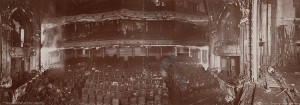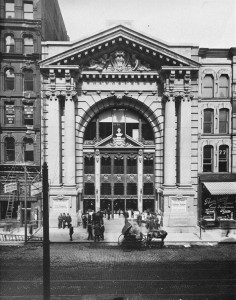The Iroquois Theater Fire
Friday, December 28th, 2018December 28, 2018
On Dec. 30, 1903, 115 years ago this Sunday, a fire at the Iroquois Theater in downtown Chicago killed 602 people. The disaster was the worst theater fire and worst single-building fire in United States history. It resulted in the institution of new fire safety laws and building codes to help prevent such a disaster from ever happening again.

This photo shows the interior of Chicago’s Iroquois Theater after it was destroyed by fire on Dec. 30, 1903. Credit: Public Domain
The Iroquois Theater had opened just a month before the fire, on Nov. 23, 1903. The beautiful new theater was claimed to be “fireproof,” but many basic fire precautions were overlooked as the owners rushed to open the building for the lucrative holiday season. The giant theater—with seating for some 1,600 people plus “standing room” for hundreds more—had no fire alarms or sprinklers and emergency smoke vents above the stage were nailed shut. Exit doors opened only inward, many structures and fixtures contained oil-based paint and other highly flammable materials, and the theater’s seating levels were separated by locking gates. The lack of care and attention given to fire safety at the Iroquois Theater proved to be disastrous.

Chicago’s Iroquois Theater was open for only five weeks before it was gutted by a disastrous fire on Dec. 30, 1903. Credit: Public Domain
The Iroquois Theater presented Mr. Bluebeard, a musical comedy, to a crowd of over 1,900 people on the afternoon of Dec 30, 1903. Another 400 performers and theater workers were crowded into the basement dressing rooms and backstage areas. During the show, a floodlight over the stage exploded, setting fire to a velvet curtain. The fire quickly spread to the oil-painted wood and canvas set pieces hanging in the catwalks and soon flaming debris was falling to the stage. An actor pleaded for people to remain calm, but the audience panicked and tried to flee the theater, which was quickly filling with flames and smoke.
Unfortunately, many of the theater’s exits were locked or hidden behind curtains. Other doors were unlocked, but they only opened inward, trapping people as they were pressed from behind by more and more people. The trapped people were quickly overcome by flames and smoke. After a stagehand ran to the nearest fire station, firefighters arrived to find theater doors blocked by bodies on the inside. At last, firefighters worked their way into the theater and extinguished the flames, but the damage had been done. Hundreds of dead bodies lay in the theater, and more people died from injuries in the coming days.
Investigations into the fire found numerous violations and irresponsible building practices. In the coming months and years, new fire safety laws required unlocked, outward-opening doors in theaters as well as occupancy limits, wider aisles, exit lights, automatic sprinklers, fire alarm systems, and flame resistant scenery, props, and curtains.


